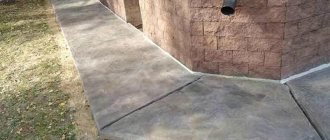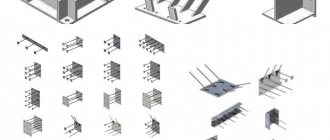How to choose the right balusters?
When choosing supports for fences of various designs, various factors are used. Among them:
- appearance;
- price;
- size;
- performance material.
When ordering fencing installations from specialized organizations, they produce structural elements from wood of the same species. The same principle must be followed when installing fencing yourself. You cannot install balusters made of oak, and railings made of alder or larch. The purchased products must have the correct geometric dimensions. They should not have:
- defects;
- deformations;
- blue on the surface;
- emptiness inside.
You should not buy products with fallen knots or made from raw wood.
Prices for various types of balusters
Balusters
Features of concrete fences
Concrete fences with figured balusters are most often found on the outside of buildings, in parks, and also in buildings with grandiose staircase structures. To make such beauty with your own hands, you need to have at least basic information about these products. They are made by pouring into a mold, and therefore can take almost any configuration, depending on the matrix used.
Concrete balusters can be made either whole or in half, and subsequently connected using an adhesive solution.
Let's consider the advantages of concrete balusters:
- Strength. They can compete with metal and are significantly superior to wood.
- Solidity. They look like a solid, massive and reliable structure.
- Wear resistance. When using high-quality raw materials, it does not crumble, does not break, and is not afraid of water and sun.
- Decorative. They carry a huge aesthetic load.
- Easy care. They do not need to be treated with specific impregnations or polished to a shine.
- Variety of shapes and sizes. There are no limits to your imagination when creating a template.
- Possibility of simulating other materials. They can be further decorated with stone, marble of any color and texture.
Strength and wear resistance are the main advantages of concrete fences
Manufacturing technology of wooden balusters
The wood lends itself well to processing. This allows you to apply patterns of various types and complexity to the surface of the blank balusters. Craftsmen create supports suitable for interiors from modern to high-tech. Work begins with the development of a product sketch. After its approval, a drawing is drawn up indicating all dimensions, including bends and cuts. Before starting to manufacture the support, the dimensions indicated in the drawing are transferred to the workpiece and marks are made. Each of them is assigned a number. Cutting out decorative parts requires cutters of various shapes.
Cutters for cutting out decorative elements on balusters
Round supports are made using the rotation method. The operation of lathes is based on this principle. They are adapted for processing blanks made from various types of wood. In a lathe, the workpiece is fixed in the spindle head. It rotates at a given speed around its axis. The ornament is applied to the surface using a rigidly fixed support of the cutter. The position of the tool is adjusted using movable slides. They can move manually or automatically. The type of ornament applied to the surface of the blank depends on the position of the cutter.
On milling machines, a rotating spindle is used to secure the cutter. A stationary workpiece is fed to it using a support. The industry produces universal machines that combine turning and milling functions. They make products with complex ornaments. In the absence of universal CNC equipment, difficult-to-cut patterns are made on sequentially used lathes and milling machines.
Making balusters on a CNC machine
After applying the pattern to the surface of the products, they undergo finishing treatment. First, the supports are ground by hand or machine and then polished. Products prepared in this way can be coated with wood varnish or paint.
Find out how to age wood with your own hands, and also familiarize yourself with aging methods and mistakes when working in a special article on our portal.
Video - How to make Roman-type balusters yourself?
Flat balusters: step-by-step instructions
Flat supports are easiest to make yourself. Their production does not require complex equipment. Skillfully made supports have an attractive appearance. They can decorate any interior.
Step 1. The first stage of work is devoted to preparing the materials and tools necessary for the manufacture of balusters: jigsaw, paper, marker, scissors, ruler, sandpaper or sanding machine, dry boards or plywood.
Electric jigsaw
Prices for popular models of jigsaws
Jigsaw
Step 2. At the second stage, a sketch of the future support is developed. To do this, the full size of the contours of the product and patterns are applied to the paper. After this, a support template is cut out according to the dimensions marked on the paper.
Stencils
Step 3. The third stage is devoted to applying a stencil to the workpiece, drawing the contours of the future product on it and cutting out a support along them with a jigsaw.
Flat balusters cut with a jigsaw
Step 4. At the fourth stage of work, the surface of the products is processed. For these purposes, use sandpaper or a grinding machine.
Prices for popular models of sanders
Sanders
Sanding a piece of wood with an emery wheel
Step 5. To extend the service life of products, their surface is treated with an antiseptic. After it dries, the supports are coated with wood varnish. This improves their aesthetic appearance.
Features of varnishing stairs
Find out how to make a wooden countertop for a bathroom sink with your own hands in a special article on our portal.
Primary requirements
In order to avoid problems in the future when making balusters from concrete, certain requirements must be observed. First of all, this concerns the composition of concrete. For all products it must be the same, this applies to both the brand of ingredients and their proportions.
The second important nuance is the configuration of the baluster. It can contain a huge number of different figured elements. It is important to correctly calculate the maximum permissible load on its base. Please note that in the future a handrail will be installed on the fence, and people will also lean on it.
Its strength depends on the configuration of the baluster
The most important thing at this point is the minimum thickness of the fragments, especially for those areas that are located below the upper third. For balusters made by hand, the minimum value is set to approximately 30 mm in cross-section.
Additionally, provide for the presence of reinforcing parts in the design; they will increase the strength of the product and help maintain its shape. They can also be useful when installing fencing.
Mounting supports: options
When choosing the fastening of supports for enclosing structures, various factors are taken into account:
- wood type;
- size and shape of products;
- fencing design.
Professional craftsmen most often use wooden pins or dowels to attach volumetric supports. It is recommended not to make their diameter larger than 1/4 of the diameter of the baluster base. This may cause the product to crack.
Fencing fastening diagram
According to the requirements of the current SNiP, fencing is installed on stairs with more than 5 steps. The minimum distance between the supports is 10-15 cm. The upper part of the supports is attached to the handrails. The method of fixing the lower part of the balusters depends on the type of structure. They can connect:
- with steps;
- bowstring or stringer;
- landing.
It is not allowed to use nails to connect structural elements. During use they quickly become loose. This leads to loss of strength and imbalance of the fence. When fastening balusters to a narrow string, a special board of greater width is placed on it. It serves as the lower support of the baluster.
Staircase design elements
Incorrectly installed and poorly secured supports make the operation of the ladder dangerous. The most durable mounting should have support posts. Intermediate balusters are installed between them at equal intervals. When attaching the supports to the string, their base and upper part are cut to the slope angle of the flight of stairs.
Fastening supports with dowels
The fastening process begins with marking the location for drilling holes for installing dowels. It is located exactly in the center of the base of the baluster. The depth of the hole is equal to 1/2 the length of the dowel inserted into it. The strength of the connection of structural elements is increased with the help of wood glue. They fill the hole before installing the dowel.
Scheme of fastening the structure with a dowel
The recesses are drilled in 2 stages. They start with a hole with a diameter of 5 mm, and then gradually expand it, changing drills of different diameters. The dowel should not go completely into the hole. The length of the outer ends of the fasteners must be at least 5.5-6 cm. Before installation in the base of the stairs, they are lubricated with glue and sprinkled with fine sawdust. This increases the adhesion strength of structural elements.
Fastening the supports with a metal pin
One end of the fastener should have a screw thread, the other should have a nut thread. The depth of the hole for the stud in the base depends on the length of the fastener. Usually it is from 10 to 20 cm. First, a 1-2 mm indentation is made with a drill in the center of the base of the support. After this, they begin to screw the fasteners into it. The ends of the studs protruding from the supports are inserted into the holes drilled through the steps, after which a nut and washer are put on them and tightened until they stop.
Fastener location diagram
Find out how to make a hatch to the attic with a ladder with your own hands, and also read the step-by-step instructions in a special article on our portal.
Fastening supports with self-tapping screws
The easiest and fastest way to attach. Self-tapping screws ensure the strength of the connection of the elements, but have one big drawback - after installation of the structure, their caps are visible. This spoils the aesthetic appearance of the staircase. This type of fastening is widely used for connecting flat balusters when constructing gazebos and porch railings.











